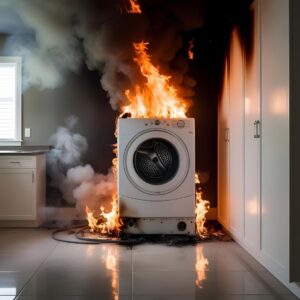In terms of home safety, we frequently neglect a surprising danger that is visibly present—our dryer. How do dryer fires start? As reported by the National Fire Protection Association (NFPA), dryers cause roughly 13,820 residential fires each year in the U.S., leading to millions in property damage, injuries, and loss of life. What is most concerning? Most of these fires can be avoided.
If you’ve ever thought, “What causes dryer fires?” or wondered, “How do dryer fires start?” you’re not the only one. This blog examines the frequent triggers of dryer fires and offers useful advice for prevention, keeping your home secure and your dryer functioning effectively.

Common Causes of Dryer Fires
Dryer fires don’t occur randomly, and grasping their underlying causes is the initial step to prevention. Let’s analyze the three most frequent offenders.
Lint Buildup
Why does lint buildup happen?
Lint, consisting of minuscule fibers released from garments while drying, is extremely combustible. Although some lint is caught in the lint screen, a lot of it builds up over time in the dryer vent system or other concealed areas.
How does it start fires?
If the lint filter isn’t cleaned frequently or if too much lint accumulates in the exhaust ducts, the dryer may overheat. The heat, along with lint’s flammable properties, establishes ideal circumstances for a fire to start.
Did you know?
The NFPA reports that 32% of dryer fires are caused by failure to clean lint traps.
Vent Blockage
What causes vent blockage?
Dryers depend on unrestricted airflow for safe operation. Eventually, lint, debris, or bird nests can block the vent, leading to limited airflow.
Why is this dangerous?
Blocked vents trap hot air inside the dryer, increasing heat levels beyond safe limits. This overheating can lead to materials combusting, especially if ignitable lint is present.
Warning signs of a blocked vent:
- Clothes taking longer than usual to dry
- A burning smell when the dryer is in use
- The dryer itself feels excessively hot to the touch
Mechanical Issues
How can mechanical issues contribute to fires?
Defective wiring, aged internal parts, or thermostat issues may cause overheating or short circuits.
Common examples include:
- Loose electrical connections sparking inside the appliance
- Motors overheating after prolonged use
- Defective thermostats failing to control the dryer’s temperature
Routine maintenance can significantly reduce the likelihood of mechanical faults turning into fire hazards.
Pro Tip
If your dryer is older than 10 years, think about replacing it with a modern, energy-efficient model that has improved safety features.
Prevention Tips
Fires can be frightening, but the positive aspect is they can be avoided. By implementing these steps, you can greatly minimize the likelihood of dryer fires in your residence.
Regular Cleaning
Start with the lint trap.
Emptying your dryer’s lint filter after each cycle is one of the easiest yet most impactful methods to lower fire hazards. Here’s the way to go about it:
- Remove the lint screen after each load.
- Clear visible lint using your hand or a soft brush.
- Occasionally rinse the lint screen with water to remove fabric softener residue.
Don’t forget the dryer drum.
Wipe the interior of the drum monthly to remove any debris left behind by clothes.
Quick Tip
Inspect the area beneath and around the dryer to ensure no lint has accumulated outside the unit.
Vent Maintenance
Inspect your dryer vents regularly.
A clean vent system helps ensure your dryer operates safely and efficiently. Here’s how to maintain it:
- Every 6 months: Check the vent hose for damage or kinks.
- Annually: Deep clean the dryer vent by detaching the hose and using a vacuum or vent cleaning brush to remove lint.
- Replace damaged hoses: Switch to a metal vent if your dryer is presently using a plastic or vinyl hose, since these materials are more likely to ignite.
Signs your vent needs cleaning ASAP:
- The outside vent flap isn’t fully opening while the dryer runs.
- Clothes smell musty or excessively damp after drying.
- Your dryer consistently overheats or shuts off mid-cycle.
Professional Inspections
Why hire a pro?
DIY upkeep is beneficial, but expert dryer evaluations can identify concealed problems (such as internal electrical issues or difficult-to-access lint accumulation) that you may overlook.
Many appliance specialists advise arranging professional dryer maintenance annually, particularly for homes that use their dryer often.
Find a certified technician in your area to:
- Check your dryer’s electrical components
- Perform a thorough vent and system cleaning
- Assess your appliance’s overall safety and efficiency
Bonus Tip
Request your qualified technician to inspect air circulation in your home, particularly around the laundry area.
Prioritize Prevention for a Safer Home
Dryer fires pose a genuine threat, making it important to understand, “How do dryer fires start?” The answer lies in prevention. By regularly cleaning your dryer, maintaining the vent system, and scheduling professional inspections, you can eliminate the risk and protect your home and loved ones.
It only takes a few minutes after every load or a yearly check-up to avoid a life-altering hazard. Don’t wait for warning signs—act now to prevent a fire and the potential burden of selling a fire-damaged house.
Previous